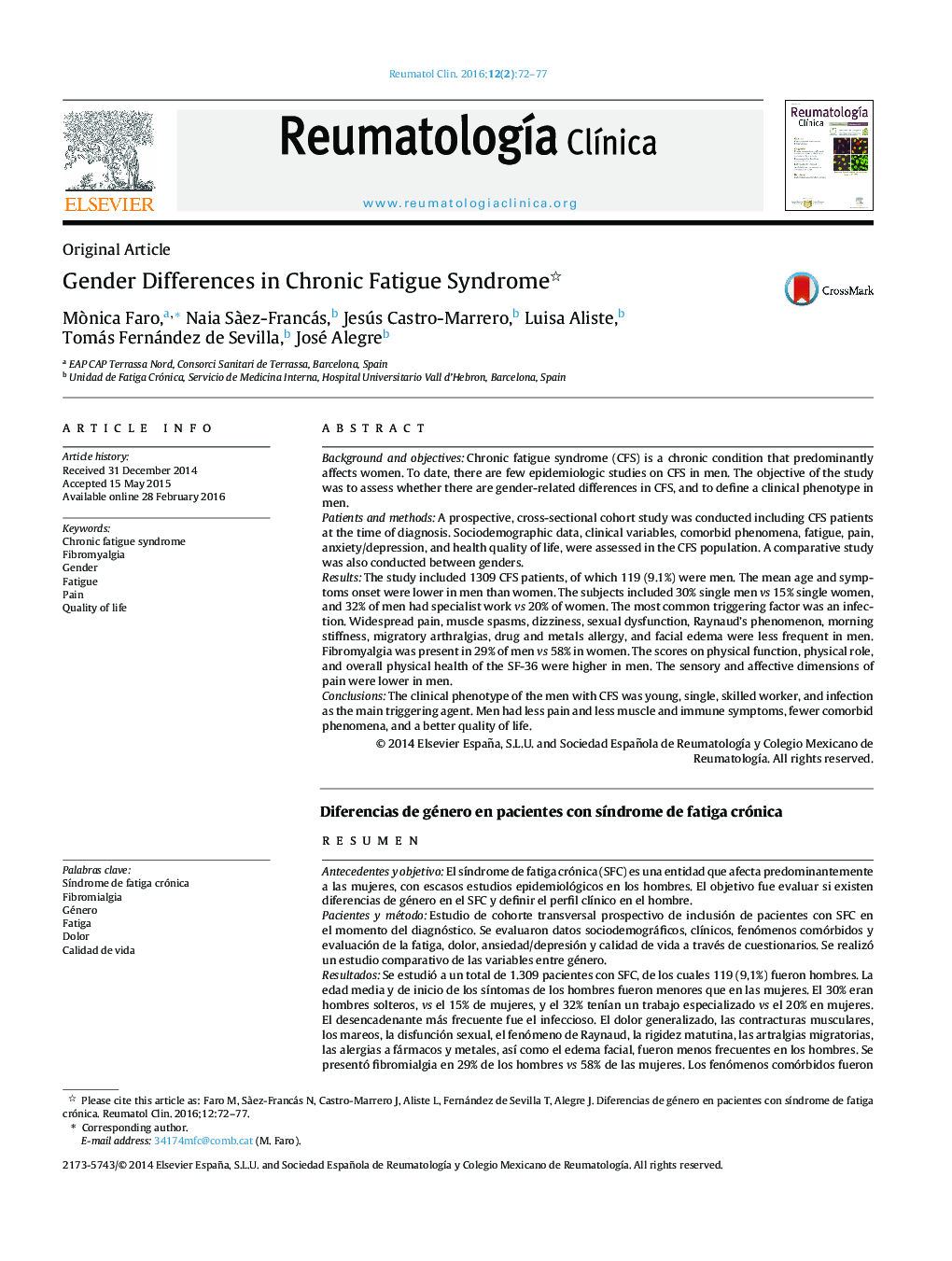| کد مقاله | کد نشریه | سال انتشار | مقاله انگلیسی | نسخه تمام متن |
|---|---|---|---|---|
| 3384079 | 1220510 | 2016 | 6 صفحه PDF | دانلود رایگان |
Background and objectivesChronic fatigue syndrome (CFS) is a chronic condition that predominantly affects women. To date, there are few epidemiologic studies on CFS in men. The objective of the study was to assess whether there are gender-related differences in CFS, and to define a clinical phenotype in men.Patients and methodsA prospective, cross-sectional cohort study was conducted including CFS patients at the time of diagnosis. Sociodemographic data, clinical variables, comorbid phenomena, fatigue, pain, anxiety/depression, and health quality of life, were assessed in the CFS population. A comparative study was also conducted between genders.ResultsThe study included 1309 CFS patients, of which 119 (9.1%) were men. The mean age and symptoms onset were lower in men than women. The subjects included 30% single men vs 15% single women, and 32% of men had specialist work vs 20% of women. The most common triggering factor was an infection. Widespread pain, muscle spasms, dizziness, sexual dysfunction, Raynaud's phenomenon, morning stiffness, migratory arthralgias, drug and metals allergy, and facial edema were less frequent in men. Fibromyalgia was present in 29% of men vs 58% in women. The scores on physical function, physical role, and overall physical health of the SF-36 were higher in men. The sensory and affective dimensions of pain were lower in men.ConclusionsThe clinical phenotype of the men with CFS was young, single, skilled worker, and infection as the main triggering agent. Men had less pain and less muscle and immune symptoms, fewer comorbid phenomena, and a better quality of life.
ResumenAntecedentes y objetivoEl síndrome de fatiga crónica (SFC) es una entidad que afecta predominantemente a las mujeres, con escasos estudios epidemiológicos en los hombres. El objetivo fue evaluar si existen diferencias de género en el SFC y definir el perfil clínico en el hombre.Pacientes y métodoEstudio de cohorte transversal prospectivo de inclusión de pacientes con SFC en el momento del diagnóstico. Se evaluaron datos sociodemográficos, clínicos, fenómenos comórbidos y evaluación de la fatiga, dolor, ansiedad/depresión y calidad de vida a través de cuestionarios. Se realizó un estudio comparativo de las variables entre género.ResultadosSe estudió a un total de 1.309 pacientes con SFC, de los cuales 119 (9,1%) fueron hombres. La edad media y de inicio de los síntomas de los hombres fueron menores que en las mujeres. El 30% eran hombres solteros, vs el 15% de mujeres, y el 32% tenían un trabajo especializado vs el 20% en mujeres. El desencadenante más frecuente fue el infeccioso. El dolor generalizado, las contracturas musculares, los mareos, la disfunción sexual, el fenómeno de Raynaud, la rigidez matutina, las artralgias migratorias, las alergias a fármacos y metales, así como el edema facial, fueron menos frecuentes en los hombres. Se presentó fibromialgia en 29% de los hombres vs 58% de las mujeres. Los fenómenos comórbidos fueron menos frecuentes en los hombres. Las puntuaciones en la función física, el rol físico y la salud física global del SF-36 fueron más altas en los hombres. Las dimensiones sensorial y afectiva del dolor fueron inferiores en los hombres.ConclusionesEl perfil clínico del hombre fue el de un paciente más joven, soltero, con trabajo especializado y con un desencadenante infeccioso. Los hombres presentaron menor dolor, menor sintomatología muscular e inmune, menor número de fenómenos comórbidos y mejor calidad de vida.
Journal: Reumatología Clínica (English Edition) - Volume 12, Issue 2, March–April 2016, Pages 72–77
